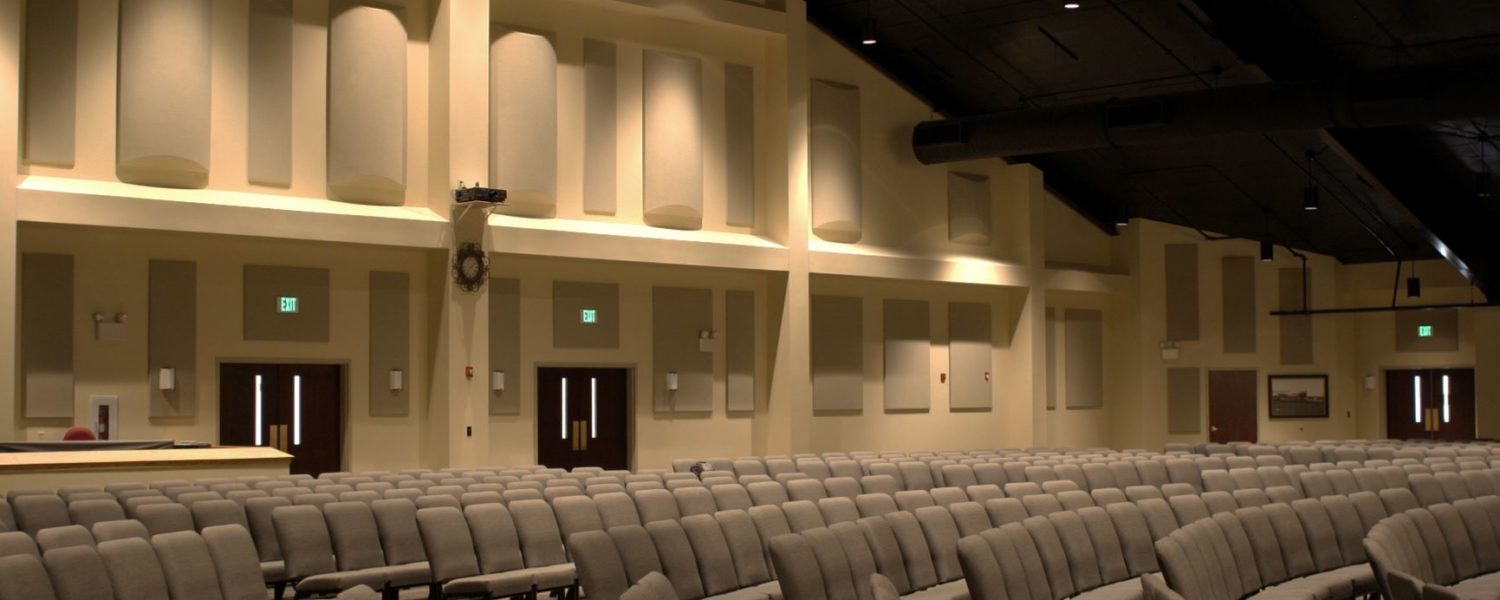By Jim DeGrandis
Ever wonder why some rooms sound better than others? What components contribute to perception of sound in a space? What knowledge do you need to solve the sound problems that you have?
The System
When people read the heading “The System,” there will be a great number who assume I am talking about the “sound system” in a room – the speakers, amplifiers, signal processors, and other electronic components that generally produce sound in a space. This is only part of the acoustic system that creates the soundscape we hear when we are exposed to sound in a space.
Yes, sound comes out of speakers, and they are important, but the source of sound isn’t what gives us a perception of the space we are in – it’s the space itself!
The walls, ceiling, floors, seats, sculptures, drapes, artwork, construction, and even people in the space are all contributing to how we perceive that sound source in any given acoustic environment. I’m not saying that the speakers aren’t important – but they are just the source of sound.
If you have a room with a 5-second reverb time, it doesn’t matter what type of speakers you have, any sound they make is going to continue to be heard for five seconds – as is every sound afterward.
What does this mean? Even if you have the best speakers in the world in that room, it will sound terrible (unless you are listening to Gregorian Chants…then it will sound awesome.)
However, if someone is speaking at a normal rate of speed, it will be unintelligible after the first 2 or 3 words – as those words will continue to bounce around with the sound of the next 15 words…like listening to 15 people all saying different things at the same time.
Your room is an acoustic system – from the sound source, to the ears of the listeners – as well as everything in, around, and even outside of that room.
The Acoustician
Have you ever watched an acoustical consultant begin the analysis of a new space? It’s fascinating. You will undoubtedly see them walking around the room while making noises – clapping their hands, snapping their fingers, whistling, even talking loudly, shouting, and singing.
It’s as if they are bats using different sounds to figure out the characteristics of the room they are in. They are, in fact, analyzing the room’s acoustic system. Where does sound reflect? Are there echoes or flutter? What is the character of the reverb? They look at the structure, materials, corners, architectural elements, floors, carpets, walls, windows, doors, ceilings and more.
Note: They begin this analysis WITHOUT using the speakers.
Why? If the room is bad, your speakers will not fix it.
What are they doing? They are listening. That’s it. Nothing fancy here – just listening.
I will say that many acousticians have done this so many times, in so many different spaces, that they have an idea of what the room is going to sound like, without even making a peep – just by looking at it. What are they looking for? What are they listening to? What can you learn from this?
Time to Listen
Everyone has a room where they dislike the acoustics. Go in there. Clap your hands. What happened? Clap again. Snap your fingers. Make some noise – but make sure to listen. Where is the sound coming from? Turn around, clap again. Walk to another area…clap.
As you walk around, you will hear the sound change. Turn your head. Is the sound coming from the corner, the ceiling, both? Angle your ears in between two corners. Maybe that’s where it’s coming from. Is there a large open balcony or a curved wall? Ask yourself these questions as you walk around and listen.
Are any of the surfaces hard? What about the floor? Is the sound lingering over your head up in the ceiling? Is there a defined slap off the back wall when you clap your hands? Is there a ringing noise? Does the echo wash over you and linger?
Sharpen your listening skills. Map the room with your ears.
What Are You Doing in the Room?
This is an important question. For most uses involving speaking and understanding speech, there are some good general targets. For example, for most rooms over 100m3 (15’ cube), a 0.8 to 1.7 second reverb time is ideal for many different functions.
However, keep in mind, some spaces may have special reverb requirements. If you’re doing Gregorian Chants, a three to five second reverb time is still great!
Now, How Do You Fix It?
Most rooms are going to benefit from reducing the acoustic energy in the space. Absorption is the most direct and easy to understand method – add soft stuff.
This sounds overly simple, but the initial experiments on calculating absorption were done by moving around seat cushions – simple, but effective.
Fabric-wrapped absorber panels are today’s high-tech equivalent to the seat cushions. Curtains, blankets, carpets, and other soft materials will also help to reduce the acoustic energy of a space.
Treatments like diffusers help to reduce focused acoustic reflections by spreading the energy around. When sound hits a surface that is not flat, it will cover the entire surface, bending around the corners and curves, and then bounces off in different directions.
This reduces what we refer to as ‘specular’ reflections – or direct, mirror reflections – which are responsible for slap echoes, ringing, and flutter.
However, some hard, reflective surfaces in the front of the room can be beneficial to help reinforce acoustic sound sources, like speaking, singing, or acoustic instruments.
Treating corners with bass traps can help to reduce bass buildup, as well as corner reflections, which can cause other clarity issues within the listening environment.
Don’t forget…look to the ceiling for rafters and other elements that cause sound to bounce around and put some absorption up there.
Jim DeGrandis is a research and development engineer at Acoustics First Corporation, member of the Acoustical Society of America (ASA), and works with ASTM International on the development of new acoustic testing standards. He frequently lectures about acoustic phenomena, simulation, and architectural acoustic design, www.acousticsfirst.com.












